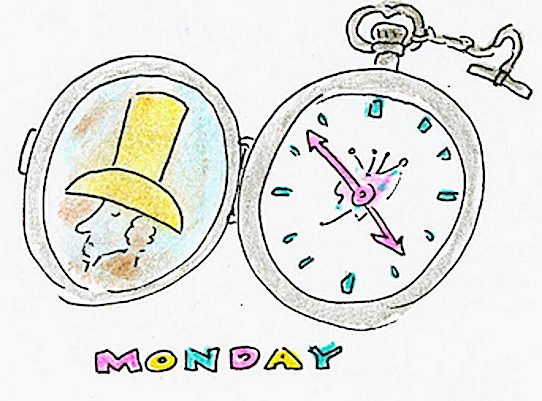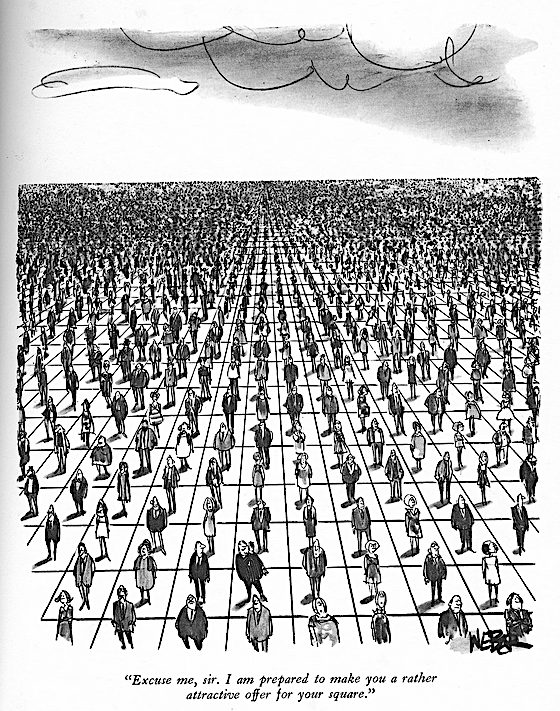 Thoughts On A 50 Year Old Issue Of The New Yorker
Thoughts On A 50 Year Old Issue Of The New Yorker
It being the second half of a double issue week, the Monday Tilley Watch will return next Monday. In its place I’ve decided to time travel 50 years in the past for a look thru The New Yorker issue of May 1, 1971.
 The cover is by the late Mischa Richter; his second cover (of three) in his 61 year run at The New Yorker — it’s a real eye catcher, perhaps (probably?) marking the second Earth Day. While I don’t know for certain, I could see how this might’ve been submitted by Mr. Richter as a b&w drawing (a cartoon) only to be recognized by the then Art Editor, James Geraghty as a cover contender. In those days, one editor, the Art Editor, edited all the art: covers, drawings, illustrations. It wasn’t until Tina Brown came aboard as senior editor that the department was split up, with an editor designated for cartoons, one responsible for illustrations, and one responsible for covers.
The cover is by the late Mischa Richter; his second cover (of three) in his 61 year run at The New Yorker — it’s a real eye catcher, perhaps (probably?) marking the second Earth Day. While I don’t know for certain, I could see how this might’ve been submitted by Mr. Richter as a b&w drawing (a cartoon) only to be recognized by the then Art Editor, James Geraghty as a cover contender. In those days, one editor, the Art Editor, edited all the art: covers, drawings, illustrations. It wasn’t until Tina Brown came aboard as senior editor that the department was split up, with an editor designated for cartoons, one responsible for illustrations, and one responsible for covers.
The week this issue came out, I was about to graduate high school, already a few years into submitting to and being rejected by The New Yorker. Courtesy of Mr. Geraghty, I was well schooled in the fine art of handling rejection. This issue, like all the others in those years, would have been one I sat with and carefully examined, trying my best to unlock the secret of what makes a cartoon a New Yorker cartoon. The secret, I discovered, is that there is no secret (I wouldn’t get anywhere at the magazine for another five years. By then Lee Lorenz had succeeded Mr. Geraghty as Art Editor).
Looking at the Table of Contents for this issue I’m struck by a number of things.
 Firstly, of the stellar line-up of cartoonists, two of the cartoonists — two of its giants I should say — are still very much contributing to the magazine: Edward Koren and George Booth. That this is so is in one of the best traditions of the magazine. Mr. Koren, our longest-contributing artist is about to celebrate his 59th year of contributing to The New Yorker (his first drawing appeared in the issue of May 26, 1962). His cartoon in this issue from 1971 made me laugh out loud, as did George Booth’s. The drawing (shown below) by Robert Weber is, to me, one of his finest (it is reproduced, full page in The New Yorker Album of Drawings 1925- 1975). What a fabulous effort. Weber, like (for instance) Peter Arno before him, was a master of taking on the big picture. That we have never seen a Weber anthology is one of the biggest black holes in the history of the magazine’s artists library (I need to remind myself that Lee Lorenz told me that Weber did not want to see a Weber anthology, so there’s that).
Firstly, of the stellar line-up of cartoonists, two of the cartoonists — two of its giants I should say — are still very much contributing to the magazine: Edward Koren and George Booth. That this is so is in one of the best traditions of the magazine. Mr. Koren, our longest-contributing artist is about to celebrate his 59th year of contributing to The New Yorker (his first drawing appeared in the issue of May 26, 1962). His cartoon in this issue from 1971 made me laugh out loud, as did George Booth’s. The drawing (shown below) by Robert Weber is, to me, one of his finest (it is reproduced, full page in The New Yorker Album of Drawings 1925- 1975). What a fabulous effort. Weber, like (for instance) Peter Arno before him, was a master of taking on the big picture. That we have never seen a Weber anthology is one of the biggest black holes in the history of the magazine’s artists library (I need to remind myself that Lee Lorenz told me that Weber did not want to see a Weber anthology, so there’s that).
Looking at the other drawings in the issue, it’s obvious it serves as a sort of primer for so many of the well-trod cartoon themes and situations played out weekly in the magazine then, and now: Dana Fradon’s woman in front of the television; Frank Modell’s men in suits dealing with an only in cartoonworld issue (in this case a defecting circus bear); Lee Lorenz with a sign-ladden drawing (Lorenz loves using signs in his work. Check out his collection, The Golden Age Of Trash and his very first first collection, Here It Comes — it features the title within a sign). The issue ends with three stellar drawings by three stellar cartoonists (a fourth stellar cartoonist, the aforementioned Dana Fradon has a second cartoon in the issue appearing at the end): the laugh out loud drawings by Edward Koren and George Booth, and a captionless drawing by William Steig of a happy fellow holding a microphone up to a singing bird sitting on a branch of a tree. Not a “funny” laugh out loud drawing but surely a drawing instructive to me at the time, fifty years ago, that some of the best New Yorker cartoons have other ways of making us laugh.

